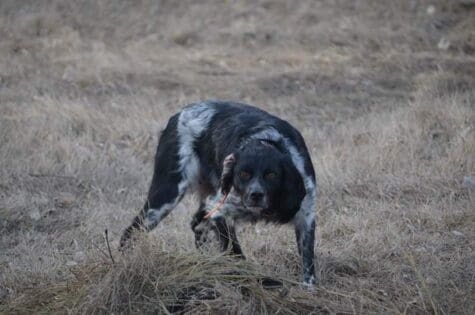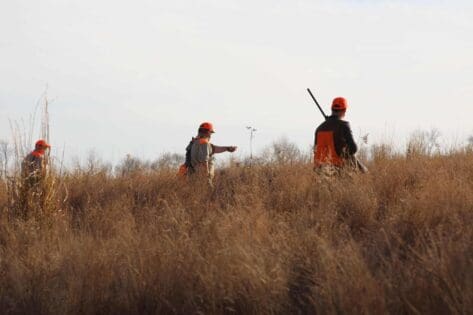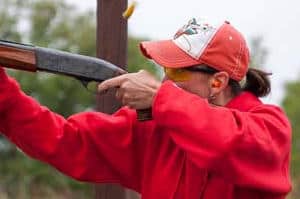Clothing and Gun Selection for the Beginner Upland Hunter
Upland season is quickly approaching. Our thoughts are turning to getting out in the field and enjoying the beautiful weather and the chance to harvest a monster buck or to get involved with some waterfowl or upland bird hunting. In my last blog, I indicated that we would discuss some of the basics of outfitting your youngsters with the proper hunting equipment. Encouraging young children to partake in various outdoor activities is something that they can enjoy for a lifetime.
 In that blog I poised the question, Will Your Grandchildren Hunt? I pointed out that fewer and fewer hunters exist today for a variety of reasons. In the current Missouri Conservationist, which was just delivered, it stated that Missouri has a population of nearly 6 million people. There are 800,000 hunters in that population. So that means that only about 13% of the population is involved in hunting activities. I know from other data for example that in Missouri only 30-40 years ago there were close to 350,000 quail hunters who harvested approximately 3.5 million (yes million) quail annually. Today there are less than 30,000 quail hunters and they harvest less than 300,000 quail. This is quite a change over the course of a relatively short period of time.
In that blog I poised the question, Will Your Grandchildren Hunt? I pointed out that fewer and fewer hunters exist today for a variety of reasons. In the current Missouri Conservationist, which was just delivered, it stated that Missouri has a population of nearly 6 million people. There are 800,000 hunters in that population. So that means that only about 13% of the population is involved in hunting activities. I know from other data for example that in Missouri only 30-40 years ago there were close to 350,000 quail hunters who harvested approximately 3.5 million (yes million) quail annually. Today there are less than 30,000 quail hunters and they harvest less than 300,000 quail. This is quite a change over the course of a relatively short period of time.
But I digress, let’s talk about getting our young folks involved in hunting activities. First and most important is the fact that they must enjoy what you are teaching them to do. Picking out the right clothing, footwear and gun are critical to their enjoyment of the sport.
Clothing-Shirts/Jackets- Today there are many options in this area. I always prefer to have plenty of clothing available in the event that the weather turns cold or wet. Of course, today we have the advantage of the modern forecasting systems and the internet to check to see what is going to be going on weather wise for a number of days out. Consider the forecast; take along lighter clothing for warm weather. There are a wide variety of lightweight materials available today that breathe and allow air flow to help keep the body cool. Likewise, there are heavy duty materials that will keep the wind and cold out and allow for the evaporation of sweat to prevent getting and staying cold. Rain proof field wear is available as well in a variety of styles and designs. Most of which, do a good job at keeping the wearer warm and dry. Socks are very important; a thick sole and heel pad add comfort and reduce the chance for blisters. They keep feet warm and dry as well if they are made from the wicking type of material that allows moisture to exist from around the feet.
 Hunting vest-again many options exist, consider the game being pursued and the law requirements to be legal with regard to the amount of hunter/blaze orange that you must wear while hunting. This can vary depending on what game is being hunted. A removable game bag may be desirable, but sometimes zipper problems can make them more of a nuisance. I prefer a sturdy vest over a hunting coat as the vest allows for better movement and is cooler in warm weather. It is also much lighter in weight which can be important if you are walking for extended periods.
Hunting vest-again many options exist, consider the game being pursued and the law requirements to be legal with regard to the amount of hunter/blaze orange that you must wear while hunting. This can vary depending on what game is being hunted. A removable game bag may be desirable, but sometimes zipper problems can make them more of a nuisance. I prefer a sturdy vest over a hunting coat as the vest allows for better movement and is cooler in warm weather. It is also much lighter in weight which can be important if you are walking for extended periods.
Hunting pants-again, consider the quarry. What is the activity that is taking place and what are the weather conditions. If in a tree stand, ground blind or waterfowl pit, warm camo is of course desirable. If you are upland hunting, consider a pair of lighter weight pants for warmer weather that have brush guard fronts from the pockets down to the bottom of the pants. Chaps are also something to consider. These are desirable as they can be easily removed, and they will protect from burrs, water and mud/dirt. When you take them off the hunting pants or jeans remain relatively clean.
Boots-should be ultra-light and comfortable and they should be waterproof, have a very aggressive sole for good traction and if very cold weather is at hand they should be insulated with say a minimum of 400 grams of Thinsulate or other similar material. Remember to think about the hunting activity that you are involved with. If you are sitting with your youngster in a tree stand or in a ground blind and it is cold and you are not moving around, the more insulation in the boots the better. You may want up to 1200 grams of insulation in very cold weather. On the other hand, if you are hunting upland birds and walking constantly, the need for heavy insulation may not be so critical because of the physical activity you are involved with.
Gloves –light weight for warmer temperature, waterproof is good and for colder temperatures heavy, but not cumbersome gloves, are best. But keep in mind that you do not want to hinder or limit your youngster’s ability to maneuver and shoot comfortably. Hand warmers are always a good option to carry along and can help to make the hunt more enjoyable.
Hat-a mesh back hat is ideal if the weather is warm. The mesh allows for air to circulate and helps keep your youngster cool. Solid hats are for cold/wet weather. If it is very cold, a stocking cap or a heavy hat with ear flaps can really save the day and add to the comfort of your hunter. Again, depending on the various laws that apply, hunter or blaze orange hats may be required when in the field.
Ear Protection-a must have to protect yours and your youngsters’ ears. Either ear plugs or earmuff type are available and will serve a valuable purpose in preventing injury or damage to one’s hearing.
 Now that you have clothed yourself and your young hunter the next question is what gun you should get for the beginner. I suppose this is an age-old question and I am not sure if there is a single best answer. In my opinion, at least as an upland bird hunter, I think that a semi-automatic shotgun is the best way to go. Furthermore, I believe that a 20 or 28 gauge is best. A 12 or 16 gauge is too much gun for a youngster. No need to wear their arm and ears out shooting a big heavy stick. On the other hand, a single shot gun with a hammer is really a danger since there are too many steps involved in getting off a round. See the game, cock the hammer, which can be tricky, then aim the gun and pull the trigger. A lot is going on here and the chance of hitting the target is diminished considerably and also the possibility of an accidental discharge due to hammer slippage is very undesirable and dangerous.
Now that you have clothed yourself and your young hunter the next question is what gun you should get for the beginner. I suppose this is an age-old question and I am not sure if there is a single best answer. In my opinion, at least as an upland bird hunter, I think that a semi-automatic shotgun is the best way to go. Furthermore, I believe that a 20 or 28 gauge is best. A 12 or 16 gauge is too much gun for a youngster. No need to wear their arm and ears out shooting a big heavy stick. On the other hand, a single shot gun with a hammer is really a danger since there are too many steps involved in getting off a round. See the game, cock the hammer, which can be tricky, then aim the gun and pull the trigger. A lot is going on here and the chance of hitting the target is diminished considerably and also the possibility of an accidental discharge due to hammer slippage is very undesirable and dangerous.
Now on to the small-bore gun, the 410. Very light in weight, easy to handle but this is a gun for an expert. We have had folks come to Heartland Lodge that can do wonders with a 410, but they are seasoned hunters who have shot thousands of rounds. Going back to the semi-auto 20 or 28, give your hunter a single round and have them load their gun with the safety on. When it is time to shoot, all they have to do is remove the safety, find their target and shoot it. Knowing that they only have a single shot will teach them patience and proficiency in making every shot count. This 20- or 28-gauge gun will be one that youngsters can keep and use throughout their lifetime. Many of our upland hunters at Heartland use these gauges with great proficiency and truly enjoy shooting them.
The idea is to have your hunters enjoy the hunt, hit their targets consistently and gain confidence in their ability to do so. This is the way to get children involved, let them have success and enjoy to the fullest the full hunting experience.
For those of you who want to get their young hunters involved in deer hunting, perhaps Matt or Allen will write something on what is the most desirable firearm/bow to get for the beginner.
Roger Keller
Last Updated: July 22nd, 2024



